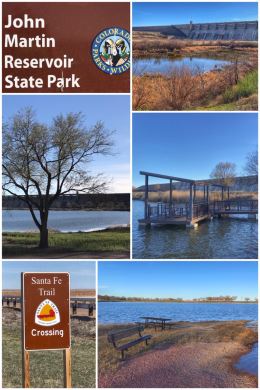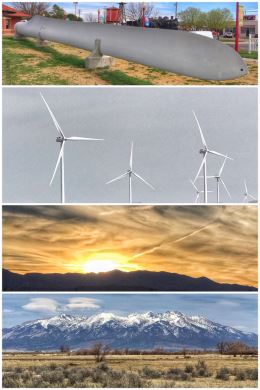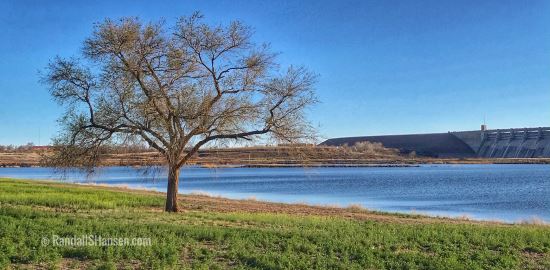
While we have nothing against the previous states we have traveled thus far in 2019, both Jen and Ran had April circled on the calendar for a reason — spending five weeks in the 20th state we have visited on this amazing adventure — Colorado. We started our travels in the southeast section of the state, spending some time in Lamar and Pueblo as we work our way clockwise around the state, ending eventually in Colorado Springs.
We enjoyed our time in Lamar, a town situated along the Santa Fe Trail and established in 1886., starting with a visit to one of the state’s welcome centers to gather additional information. Located in a historic, restored 1907 train depot, and staffed with some very wonderful people, we left with a packet of materials, along with some great ideas for hiking and exploring. The visitor center also includes a span from a wind turbine (from a huge wind turbine farm just south of town), an old train engine, and an old water tower. Located adjacent to the center is the Madonna of the Trail Monument, one of 12 identical 18-foot high statues placed in each of the 12 states along the National Old Trails Road… as a tribute to the women of the covered-wagon days
Lamar seems known for being one of the state’s top bird-watching destinations, part of the Colorado Birding Trail. (The town even hosts the High Plains Snow Goose Festival in February, celebrating the migration of the giant white snow geese.) We loved the Willow Creek Nature Trail (2 miles, RT), that starts at the entrance to Willow Creek Park.
Because we were itching for a national something, we headed to Bent’s Old Fort National Historic Site, located about 49 miles west of Lamar. The Bent brothers (Charles and William) built the outpost, along with Ceran St. Vrain, to trade with the local Native Americans — and later became a key outpost along the Santa Fe Trail. Sadly, buffalo (bison) hides became a major commodity traded. Built in 1833, it was destroyed by fire in 1849… but thanks to meticulous records, the fort was reconstructed on its original footprint by the National Park Service in the 1970s and is now open to the public — and showcases what the post might have looked like back in the 1800s. We watched a short video about the outpost and then took a self-guided tour through the 16 rooms within the fort.

As we headed back to Lamar, we stopped at John Martin Reservoir State Park for a long-awaited hike. Located about 25 miles west of Lamar, the park is known as another great location for birding, with more than 400 species of birds documented. The dam on the Arkansas River created the second largest body of water in Colorado by capacity.
Some of the Santa Fe Trail, a historic 900-mile international trade route that connected Missouri with Santa Fe (then Mexico), passes through southeastern Colorado, following the Arkansas River. For almost 60 years, between 1821 and 1880, the Santa Fe Trail, known at the Great Prairie Highway, was a vital route for trade and travel. Folks can follow the trail in their vehicles using the Santa Fe Trail Scenic & Historic Byway, which travels westward from Lamar to Trinidad.
We stopped at this state park because we had read about a wonderful hike here. And while we had a bit of trouble finding it, we succeeded in hiking several miles of the Red Shin Hiking Trail, starting from the Lake Hasty Campground. The trail is named for a Cheyenne warrior who once lived in the Arkansas Valley.
The state park offers hiking, fishing, picnicking, and camping opportunities.

If we had more time in Lamar, we would have also visited the Big Timbers Museum (named for a stand of huge cottonwood trees that grew along the Arkansas River), as well as the Granada Relocation Center (another of the Japanese camps the U.S. established during World War II). We also considered hiking in the Two Buttes area.
Instead, we continued our journey through Colorado, stopping for just one night outside of Pueblo, near Colorado City in the Greenhorn Valley… where we finally got to experience some of Colorado’s snow-capped mountains — enjoying the vista from our campground of the Wet Mountains, a sub-range of the Sangre de Cristo Mountains in the southern Rocky Mountains.
Next up? Alamosa and our next national park adventure!
